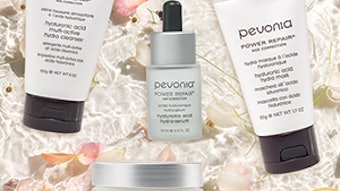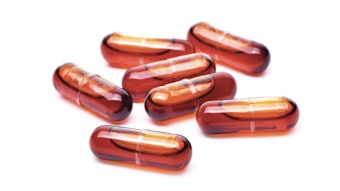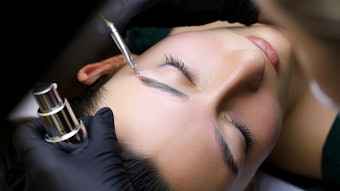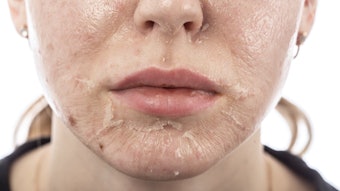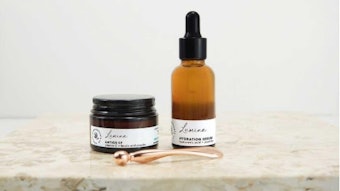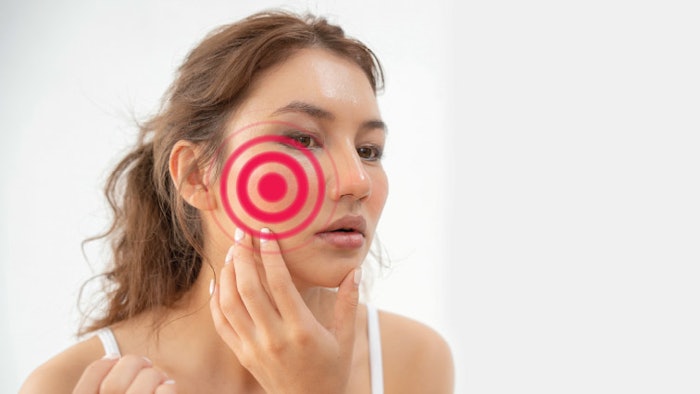
When examining clients’ skin, you’ve undoubtedly seen inflammation many times. However, how much time do you or your clients really spend thinking about this common skin ailment and the role it plays in our skin’s overall health? The likely answer for us is, not frequently, and in the case of our clients, it’s probably almost never. As licensed estheticians, we know so much about skin; however, something I love about our industry is that there’s always more to learn. Additionally, we have a poignant opportunity to educate clients on their skin care routine and lifestyle habits; Why not start by re-examining something as ubiquitous and complex as inflammation?
Log in to view the full article
When examining clients’ skin, you’ve undoubtedly seen inflammation many times. However, how much time do you or your clients really spend thinking about this common skin ailment and the role it plays in our skin’s overall health? The likely answer for us is, not frequently, and in the case of our clients, it’s probably almost never. As licensed estheticians, we know so much about skin; however, something I love about our industry is that there’s always more to learn. Additionally, we have a poignant opportunity to educate clients on their skin care routine and lifestyle habits; Why not start by re-examining something as ubiquitous and complex as inflammation?
Let’s review the common triggers for inflammation, how they can manifest in the skin, and how you can assist your clients in alleviating inflammation’s symptoms in the treatment room, in clients’ homecare routines, and in their lifestyle habits adjustments.
Inflammation 101
While it’s usually a source of discomfort for sufferers and often seen as a negative thing, inflammation serves an essential purpose in our bodies; it’s your immune system’s natural reaction to irritants and injury.1 When exposed to things like pathogens, foreign objects, certain chemicals, or in response to disease or physical injury, the immune system creates an “inflammation cascade” to assist in several of your natural healing processes. While this can happen all over the body, as an esthetician, you’ll be working with inflammation localized to the skin. Essentially, inflammation is a sign that your client’s skin is doing what it needs to in order to heal!
Signs, Symptoms and Triggers
As clever as our immune systems are, there are times when inflammation isn’t helpful.2 This is when inflammation moves into the chronic (or long-term phase) rather than acute (short-term phase). Symptoms can be especially taxing on your client when their inflammation is chronic. When examining the skin, you may notice symptoms like redness, blotchiness, and swelling; your clients may also report pain, sensitivity, burning or irritation. Perhaps even more frustrating, some types of inflammation don’t show these telltale signs, making them trickier to catch and treat.
Common inflammation triggers include:
- Environmental Stressors. The cause of your client’s inflammation may be smacking them in the face each time they step outside. Environmental stressors include everything you are exposed to in your surroundings, such as UV rays, blue light, harmful microbes, pollution, allergens or harsh chemicals. All these interact with your client’s skin as they go about their day and have the potential to cause inflammation at any point.
- Lifestyle Habits. Old habits die hard, but some of them are worth addressing if your clients want to minimize the symptoms of inflammation. Excess consumption of sugar, alcohol, dairy and high glycemic carbohydrates are all dietary habits that exacerbate the redness and irritation associated with irritation. Beyond diet, other lifestyle factors cause inflammation too. Be sure to ask your clients about their stress levels and sleep habits, as both can significantly affect inflammation.
- Heat. Whether it’s hitting the gym, a traditional sauna, basking on the beach, taking a hot shower, or cozying up with a heated blanket, embracing the warmth can sadly be linked to your client’s inflammation. However, an infrared or far-infrared sauna may be helpful to assist in the body’s healing process and resolving inflammation. Heat rashes happen when sweat gets trapped by pores, leading to inflamed skin marked by redness, bumps and itchiness. If your clients are already prone to inflammation, limiting your exposure to these influences and activities may be helpful.
- Genetics. Whether it’s passed down to us as rosacea, acne or susceptibility to rosiness, our parents may be to blame for inflammation and its irksome symptoms. While there’s nothing we can do about our genetics, you can help alleviate irritation with soothing, natural ingredients.
- Underlying Health Conditions.3 Knowing that inflammation is a sign that your body is healing, it makes perfect sense that it could show up in deeper issues to protect and initiate the healing process. Inflammation can arise as your client’s immune system tackles bacterial skin infections, including impetigo and cellulitis, fungal infections, like ringworm and allergic reactions.3 If you suspect your client is dealing with one of these issues, strongly advise them to seek medical attention. Additionally, some of these conditions are easily spread; as such, it’s essential to reschedule their treatment when necessary and to properly sanitize between each client.
Related: Calming the Inflammation Cascade
Conditions and Consequences
With so many ways inflammation can be triggered, it’s not surprising that it can manifest in many forms. However, did you know that it can be associated with various processes below the surface of the skin? As we examine skin conditions that go hand-in-hand with inflammation, we’ll also take a closer look at what’s happening physiologically within the skin.
- Acne. Whether linked to diet, bacteria or hormones, acne is characterized by the presence of pimples, papules, nodules, blackheads or whiteheads. Painful, red and swollen inflammation can accompany each breakout. For acne sufferers, the bodily processes that inflame are linked to androgens (a group of hormones that plays a role in the male reproductive system). Androgens, particularly dihydrotestosterone (DHT), have been shown to impact the skin’s overall barrier function, leaving your client’s complexion vulnerable to congestion and inflammatory reactions triggered by the bacteria, mites and yeast on the skin’s surface.4,5 Those with thick facial hair typically have higher levels of DHT and, therefore, more of the associated inflammation. Along with calming, acne-targeting treatments, you can also ask clients about their dietary habits. Dairy consumption in particular can impact DHT levels and therefore, play a role in causing or aggravating related acne.6
- Aging. Inflammation is also associated with natural aging. It’s tied to the loss of both epidermal and dermal collagen, and can be attributed to increases in production of metalloproteinases, an enzyme that breaks down collagen, reduces elastin’s ability to help skin snap back, degrades adipose tissue, and is an inflammatory response. This enzyme breaks in the subcutaneous layer, decreasing skin volume.7,8 This is one of the less obviously visible ways inflammation may impact our skin as we get older. Some likely signs that this “invisible” inflammation is hard at work are premature sagginess, fine lines and wrinkles or an overall lack of vitality.
- Hyperpigmentation. While healing, the immune system will do what it takes to help inflamed tissue repair. This includes delivering a spike in melanin to the affected areas.9 Melanin protects from the sun and gives skin, hair and eyes their unique color, but when melanin shows up in response to inflammation, it can sometimes leave hyperpigmented patches and dark spots. Typically, these last longer than the inflammation itself, meaning that hyperpigmentation can bother your client well after the inflammation subsides.
- Rosacea. Rosacea is a common condition noted for the flushed, rosy look it gives skin. Though causes of Rosacea vary from person to person, common symptoms observed in a person suffering from Rosacea include dilated or broken capillaries and blood vessels, swelling, bumps, acne-like breakouts, and a burning sensation.10 The dilation of capillaries and blood vessels (i.e. Vasodilation) occurs when blood vessels widen to improve circulation in the inflamed area.11
- Dehydration. Dehydration can wreak havoc on the entire body, including the skin. When your client’s skin is dehydrated, there is decreased activity in aquaporins (membranes that act like channels to deliver water to cells).12 Excess hyaluronidase can adversely affect hydration due to it breaking down naturally hydrating hyaluronic acid. When hydration is lacking, the skin’s moisture barrier is impacted, and your client will also face greater susceptibility to environmental stress.
Naturally Combatting Inflammation
Even though inflammation is a complex and, frequently, persistent issue, hope is not lost. There are many treatments available to combat inflamed skin. Better yet, there are many natural remedies that you can use on clients to ward off any inflammation that may occur as a result of more aggressive skin care treatments.
- Satsuma peel. Think of this as a pollution solution. This rind’s high antioxidant and vitamin C content takes on free radicals associated with pollution to halt the inflammatory cascade reaction, making it a great option in skin treatments.
- Plant peptides. These peptides are sourced from plant-based ingredients like rice or Sacha Inchi, a nutrient rich superfood seed, and they can stimulate collagen and elastin production to counter the damage caused by inflammation, as well as inhibit the enzymes responsible for breaking them down.
- Swiss Alpine plant extracts. Extracts from plants such as speedwell, yarrow and peppermint leaf, are highly effective treatments for hyperpigmentation because of their blood vessel constricting and anti-inflammatory properties. By reducing signs and reactions of inflammation, one of the primary triggers for hyperpigmentation is addressed.
- Arnica. This well-known herb is heralded for its potent anti-inflammatory actions; Arnica decreases blood stagnation to alleviate pain and both temporary and persistent inflammation.
- Natural antimicrobials. Formulas that contain tea tree, cinnamon, basil, eucalyptus, and lavender take advantage of these plants’ natural ability to ward off microorganisms that can cause or exacerbate inflammation.
- St. John’s wort. Another staple of natural medicine, St. John’s Wort has anti-inflammatory, antioxidant and anti-bacterial properties that make it popular as a topical treatment for everything from minor irritations to more severe breaks and bruises.
While there are several excellent options to lean on while working with inflamed skin, there are also things to avoid, such as products that contain artificial fragrances, and applying essential oils in their pure, undiluted form. Both can aggravate and even injure the skin, further fueling inflammation and compromising skin health. While it’s at your discretion, you may also notice that peels formulated for sensitized skin are better tolerated than those for all skin types. It’s also critical to note that if you notice inflammation that has progressed beyond what you can take on in the treatment room, please direct your client to contact their doctor.
Lifestyle Swaps for Inflammation
In addition to putting their trust in your capable hands, your clients may also want to consider consulting their doctor or natural healthcare provider for advice on making changes in their lifestyle habits that may reduce inflammation. While you can make suggestions, it is important that you reiterate that clients should consult a healthcare provider prior to making any significant changes. Here are some practices that I have found helpful that your clients may want to discuss with their healthcare provider.
- Ice Baths and Cold Showers. While not everyone loves to chill out, those desiring to manage inflammation can benefit from taking the plunge. Icy water constricts blood vessels to minimize increased blood flow that brings about swelling, burning sensations, and pain.13
- Natural Anti-inflammatories. In addition to topical application, natural ingredients can be used to help inflammation from the inside out. Foods rich in anti-inflammatory ingredients are not only delicious; they can also help curb the symptoms of inflammation. Clients may find ingredients like turmeric (which contains an anti-inflammatory phytochemical called curcumin), fish oil, spirulina, and ginger beneficial.14
- Allergy and Sensitivity Testing. Allergens are a common catalyst for inflammation, so it’s not a bad idea for your clients to undergo testing. Food allergens can be avoided, unlike those we’re exposed to through other means, so looking out for allergies to dairy, soy, gluten, eggs, nuts and seafood can be helpful. Even without sensitivity or an allergy to dairy, dairy can impact inflammation, but clients who are lactose-intolerant and have sensitivities to casein will want to remove dairy products from their diet.
Conquering Inflammation
With so many ways for it to manifest, the vast majority of your clients will experience inflammation sooner or later. And like many bodily functions, inflammation can involve much more than just the skin. Regardless of the trigger, it’s ideal to take a holistic approach that soothes and reduces inflammation through multiple means. With your knowledge, training and insight, you can formulate skin care treatments that target inflammation with natural solutions while advising clients on the bigger picture behind their irritation.
Brian Goodwin is an award-winning international educator for Éminence Organic Skin Care. As a master medical esthetician, master herbalist and consultant, Goodwin leverages over 10 years of spa industry experience to bring fun, engaging education to spa professionals around the world.
